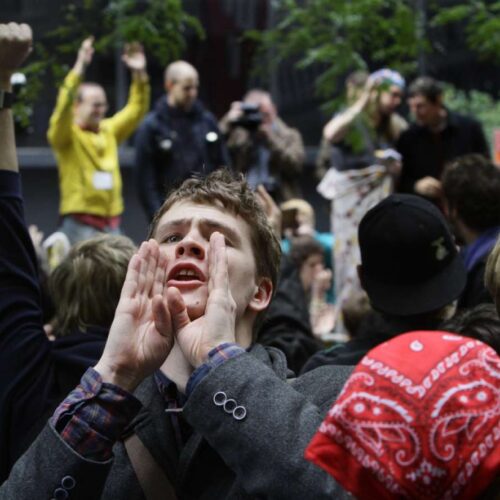Introduction
As many as a dozen “Occupy Wall Street” protestors and their allies were arrested Thursday afternoon as they tried to stop a foreclosure auction inside a courthouse in Brooklyn, N.Y.
As the auctioneer called the proceeding to order, the protestors, who had been sitting quietly in the courtroom, broke into song. “Mrs. Auctioneer, all the people here are asking you to hold all the sales right now,” they sang, in surprising harmony. “We’re hoping to survive, but we don’t know how.”
Their voices filled the courtroom and, for a while at least, brought the proceedings to a halt. After a few minutes, a court security officer warned them to stop or face arrest, but he could barely be heard over the singing. The singing continued for about a half an hour until they were led off in plastic handcuffs, still singing.
The disruption coincided with a larger protest outside the state Supreme Court building in downtown Brooklyn, across the East River from Wall Street.
“We all know there are hundreds of thousands of people who have lost their homes through nothing but outright theft,” housing activist Frank Morales told a crowd of more than 100 outside the courthouse.
The courtroom action was planned in secret by protestors linked to Occupy Wall Street and another group, “Organizing for Occupation,” which had previously formed an “eviction blockade” at the home of an 82-year-old grandmother in Brooklyn. So far, the group has been able to prevent the woman’s eviction, but the outcome of Thursday’s sing-in in the courtroom was less certain.
After the protestors were arrested, the courtroom was opened back up for the foreclosure auction. For sale on the courtroom docket was at least one residential home as well as two commercial properties. It is not known who owned the home, or what led to the foreclosure.
Nearly 1.8 million homes were hit with foreclosure actions during the first nine months of this year, according to RealtyTrac Inc., an industry data provider. That translates into roughly one out every 73 homes in the U.S.
The foreclosure rate is down slightly from 2010, when a record 2.9 million homes were hit with foreclosure actions, according to RealtyTrac.
RealtyTrac chief executive James Saccacio has said that U.S. foreclosure activity has been “mired down” since last October, when the “robo-signing” controversy sparked a series of state and federal investigations into lender foreclosure procedures.
It was a year ago today that 50 state attorneys general announced they were investigating big banks’ foreclosure tactics in the wake of reports that many were using questionable documentation to push families out of their homes.
Federal officials have also gotten involved in the negotiations with the banks. Some reports have said the government authorities and the banks have discussed a settlement that could total $20 billion. But some state authorities, including California Attorney General Kamala Harris, have said that the proposed deal isn’t tough enough on the banks. Harris has vowed to pursue an independent investigation.
Bob Davis, an executive vice president at the American Bankers Association, told Bloomberg News that an agreement hasn’t been reached because state and federal authorities are asking for “wildly excessive” payments from the banks.
“A settlement is not likely to be agreed to if one side is asking for remuneration or fines that the other side believes is wildly unbalanced to the proof of harm to consumers,” he said.
In addition to the attention from state and federal officials, the foreclosure process has also been slowed by a growing wave of activism from beleaguered homeowners, community activists and consumer attorneys. Foreclosure opponents have used social media to spread the word about questionable tactics by banks and to swap advice on legal maneuvers and grassroots tactics for blocking foreclosures.
Outside the Brooklyn courthouse Thursday, protestors held signs with various messages critical of the banking industry.
“Stop lootin’ start prosecutin’,” read one. Another named the chief executive of JP Morgan Chase & Co.: “The United States of Jamie Dimon? No! STOP unlawful foreclosures.”
Morales, the housing activist, told the crowd that inside the courthouse “moneychangers” were sitting behind closed doors passing properties back and forth. “They shuffle these things around like so many pieces of paper. They don’t realize that behind these numbers are real people.”
People involved in the auction sat stone-faced as the protestors inside the courtroom began to sing. After a while, the protestors began clapping as well. As more and more security officers, some wearing “special response team” vests, filed into the courtroom, the protestors stood and swayed, raising their voices even louder.
Occupying for Occupation said later Thursday afternoon that at least seven and as many as a dozen protestors were arrested inside the courthouse.
A reporter observed about a dozen people led away in handcuffs. Soon after, the court officer ushered the remaining crowd back into the courtroom and the auction resumed.
Read more in Inequality, Opportunity and Poverty
Finance
GOP candidates in foreclosure capital say government not the solution to crisis
Republican presidential aspirants say free market can fix foreclosure mess
Finance
Charities supporting AT&T’s buyout of T-Mobile have financial incentive
AT&T’s $39 billion purchase of T-Mobile attracts unusual backers


Join the conversation
Show Comments